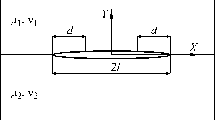Abstract
The problem analyzed is of the crack kinking away from the interface between the two different anisotropic materials. The attention is concentrated on the initiation of the crack kinking and the condition that the length of the crack segment that is leaving the interface is small in comparison to the crack segment that remains along the interface. The emphasis is placed to the application of the fracture mechanics concept for the interfacial crack that propagates dynamically between the two orthotropic materials. The simulations and calculations were done by application of the Mathematica ® programming routine. The stress intensity factors and the energy release rate are obtained for the kinked crack, as functions of the corresponding values for the interfacial crack prior to kinking. The analysis was performed of the influence of anisotropy on the crack kinking versus crack propagating along the interface competition. Due to anisotropy the kinking is easier, i.e., it is easier for the crack to kink away from the interface into the “softer” of the two materials. The oscillatory index for the case of the dynamic crack growth along the interface between the two orthotropic materials increases with crack tip speed v and with increase of the difference in stiffnesses. The practical application of this analysis could be for the interface in the glued joints and protective coatings.
Similar content being viewed by others
References
Cotterell B, Rice JR (1980) Slightly curved or kinked cracks. Int J Fracture 16: 155–169
Lekhnitskii SG (1981) Theory of elasticity of an anisotropic body. Mir Publishers, Moscow
Nikolic R, Veljkovic J (2003) Some problems of cracks on bimaterial interface. In: Sedmak S, Radakovic Z (eds) From fracture mechanics to structural integrity assessment. IFMASS 8, Belgrade, pp 61–83
Rice JR (1988) Elastic fracture mechanics concepts for interfacial cracks. J Appl Mech 55: 98–103
Suo Z (1990) Singularities, interfaces and cracks in dissimilar anisotropic media. Proc R Soc A, London 247: 331–358
Suo Z, Bao G, Fan B, Wang TC (1991) Orthotropy rescaling and implications for fracture in composites. Int J Solid Struct 28: 235–248
Suo Z, Hutchinson JW (1990) Interface crack between two elastic layers. Int J Fracture 43: 1–18
Veljkovic J (2005) The Crack Kinking Out of an Interface. Theor Appl Mech 32(3): 208–221
Wang TC, Shih CF, Suo Z (1992) Crack extension and kinking in laminates and bicrystals. Int J Solid Struct 29: 327–344
Author information
Authors and Affiliations
Corresponding author
Rights and permissions
About this article
Cite this article
Nikolić, R.R., Djoković, J.M. & Mićunović, M.V. The competition between the crack kinking away from the interface and crack propagation along the interface in elastic bicrystals. Int J Fract 164, 73–82 (2010). https://doi.org/10.1007/s10704-010-9456-y
Received:
Accepted:
Published:
Issue Date:
DOI: https://doi.org/10.1007/s10704-010-9456-y




